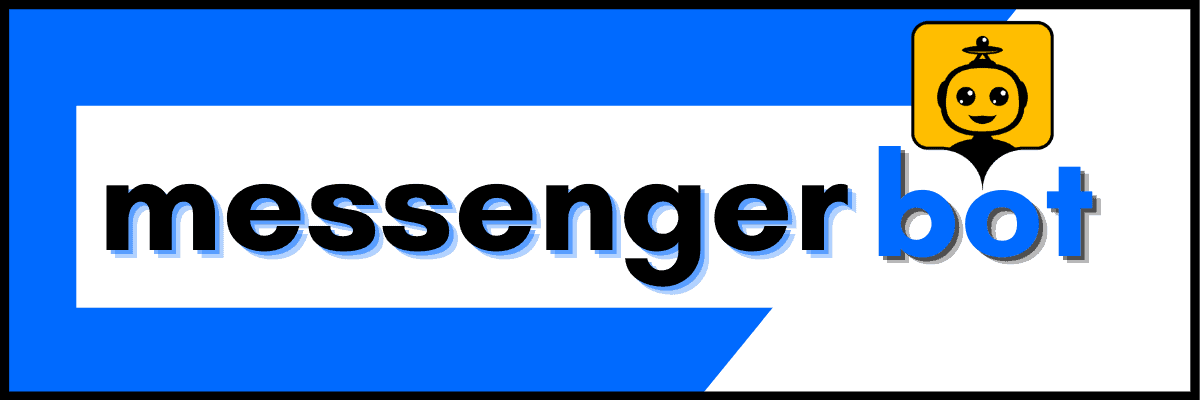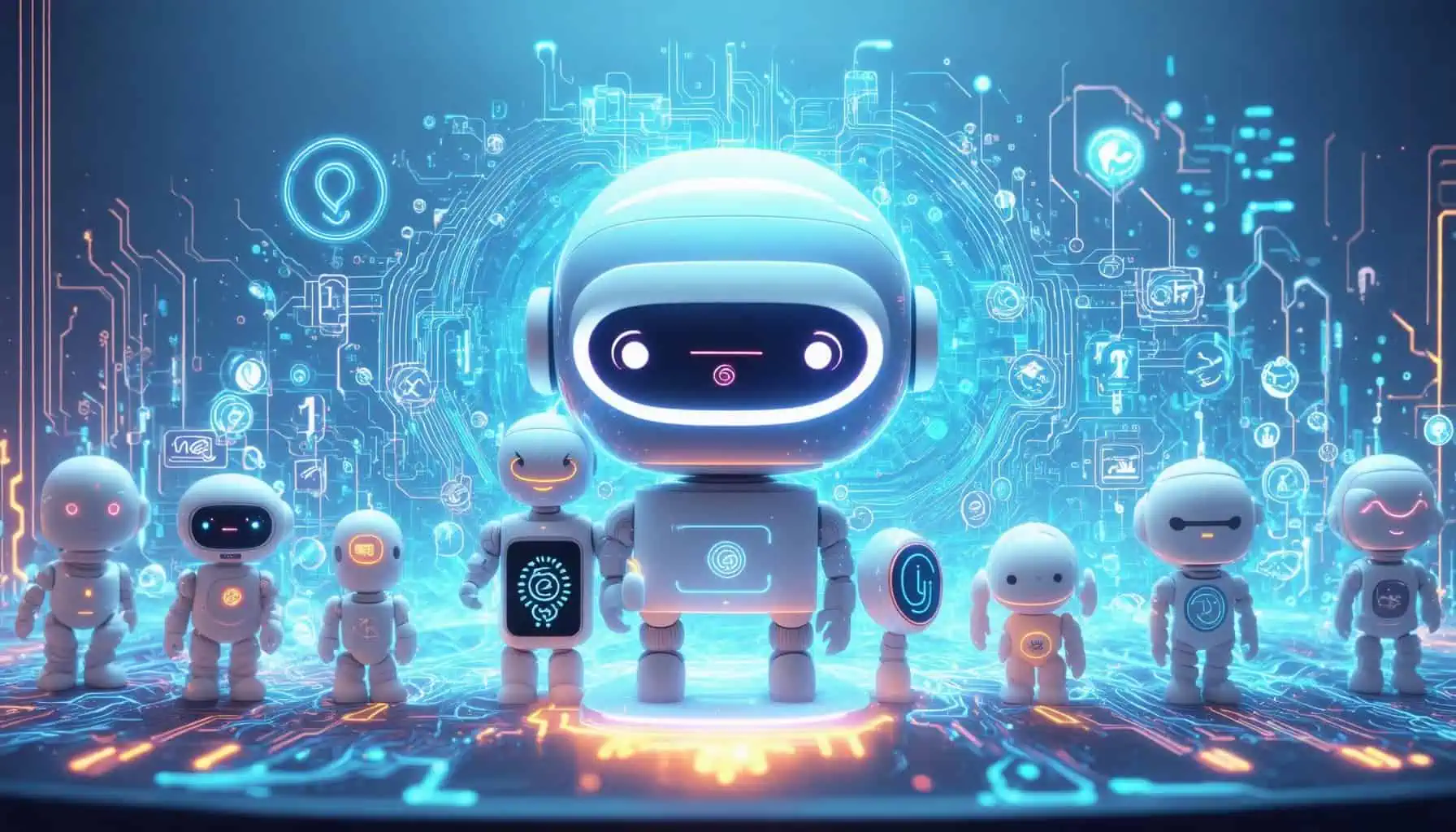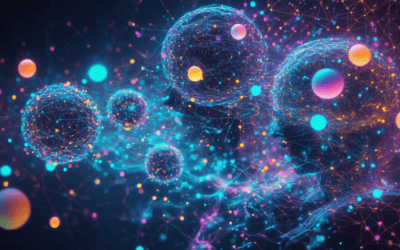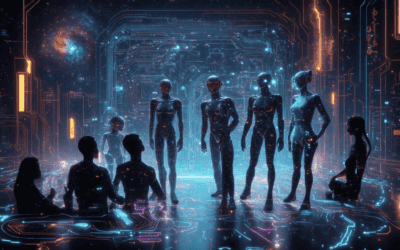关键要点
- 了解 四种主要类型的聊天机器人: 基于菜单、基于规则、人工智能驱动和语音聊天机器人,各自满足独特的用户需求。
- 探索 流行聊天机器人 像Facebook Messenger、Slack和WhatsApp机器人,增强跨平台的客户互动。
- 发现 Alexa和Siri 作为先进的聊天机器人,集成语音识别和人工智能以改善用户互动。
- 了解 最佳人工智能聊天机器人 今天可用的聊天机器人,包括Claude AI、ChatGPT和Jasper,针对各种应用量身定制。
- 保持对未来的 聊天机器人趋势, 如多语言支持和语音激活互动,塑造数字通信的格局。
在当今快速发展的数字环境中,理解 不同的聊天机器人 对于任何希望增强与技术互动的人来说都是至关重要的。本文深入探讨了聊天机器人的迷人世界,探索了 四种主要类型的聊天机器人 并提供示例,说明它们独特的功能。我们还将突出 最常见的聊天机器人 您应该了解的,包括已成为家喻户晓的流行名称。随着我们比较领先选项的功能,我们将回答一个紧迫的问题: 哪个聊天机器人最好?此外,我们将调查 Alexa 和 Siri, 检查它们在聊天机器人技术更广泛背景中的角色。最后,我们将展望未来,讨论 最先进的AI聊天机器人 以及塑造其发展的趋势。加入我们,揭示帮助您驾驭不断演变的聊天机器人格局的见解。
聊天机器人的四种类型是什么?
了解不同类型的聊天机器人对于希望增强数字通信策略的企业至关重要。每种类型都有独特的用途,并能显著影响用户参与度。以下是四种主要类型的聊天机器人:
不同类型的聊天机器人及示例
- 菜单或按钮式聊天机器人: 这些聊天机器人为用户提供一组预定义的选项,便于选择,使其简单易用。用户可以点击按钮以接收特定的响应,适合简单的查询和任务。
- 基于规则的聊天机器人: 也称为决策树聊天机器人,这些机器人基于一组预定义的规则进行操作。它们遵循脚本路径回答用户查询,适合处理常见问题。然而,它们缺乏从互动中学习的能力。
- 人工智能驱动的聊天机器人: 利用自然语言处理(NLP)和机器学习,人工智能驱动的聊天机器人可以以更对话的方式理解和响应用户查询。它们从互动中学习,随着时间的推移改善响应。这种类型包括在客户服务应用中使用的先进模型。
- 语音聊天机器人: 这些聊天机器人通过语音命令与用户互动,利用语音识别技术。它们通常出现在像亚马逊的Alexa和谷歌助手这样的虚拟助手中,允许免提操作和更直观的用户体验。
3种聊天机器人:更深入的了解
为了更深入地探索聊天机器人领域,让我们探讨三种正在获得关注的特定类型:
- 生成式AI聊天机器人: 一种较新的类别,生成式人工智能聊天机器人利用先进算法根据用户输入动态创建响应。它们可以进行更复杂的对话并提供个性化体验。
- 混合聊天机器人: 结合基于规则和人工智能驱动聊天机器人的元素,混合聊天机器人同时提供两者的优点。它们可以处理简单的查询,使用预定义规则,同时也利用人工智能管理更复杂的互动。
- 多语言聊天机器人: 这些聊天机器人可以用多种语言进行交流,使企业能够接触到多样化的全球受众。这个功能对在多个地区运营的公司特别有利,增强了不同人群的用户参与度。
整合各种聊天机器人类型可以增强用户参与度并简化客户服务流程,这一点在来自 IBM 人工智能聊天机器人 和 Salesforce聊天机器人.

最常见的聊天机器人是什么?
最常见的聊天机器人包括多种平台和技术,满足不同用户的需求。以下是一个全面的概述:
- Facebook Messenger 机器人: 这些机器人在Facebook Messenger平台上促进互动,使企业能够通过自动回复、个性化消息和客户服务支持与客户互动。根据 商业内幕, Messenger机器人可以显著增强用户参与度并简化沟通。
- Slack机器人: 集成在Slack消息平台内,这些机器人通过自动化任务、提供提醒和与其他应用程序集成来帮助团队。流行的例子包括Slackbot,它帮助用户处理提醒和常见问题,以及各种增强生产力的第三方机器人。
- WhatsApp机器人: 这些机器人使企业能够通过WhatsApp直接与客户沟通,提供订单跟踪、客户支持和促销消息等服务。来自 Juniper Research 的研究表明,WhatsApp机器人因其高打开率而越来越受欢迎。
- 谷歌助手: 这个由人工智能驱动的虚拟助手可以执行任务、回答问题并控制智能家居设备。它利用自然语言处理来理解用户查询并提供相关信息。
- 亚马逊Alexa: 作为一个语音激活的助手,Alexa可以执行多种任务,包括播放音乐、提供天气更新和控制智能家居设备。它与众多第三方应用的集成使其成为用户的多功能工具。
- ChatGPT: 由OpenAI开发的ChatGPT是一个对话式人工智能模型,可以进行类人对话、回答问题并提供各种主题的信息。它生成上下文相关回复的能力使其成为希望增强客户互动的企业的热门选择。
- Drift: 这个聊天机器人专注于营销和销售,提供与网站访问者的实时沟通。Drift的人工智能能力使其能够筛选潜在客户并安排会议,提高企业的转化率。
- Intercom: 一个客户消息平台,包括用于客户支持和参与的聊天机器人。Intercom的机器人可以回答常见查询,将对话转接给人工代理,并收集用户反馈。
总之,聊天机器人在各个平台的客户服务和参与中变得越来越重要。它们自动化互动和提供即时响应的能力使其成为希望提升用户体验和运营效率的企业的宝贵工具。有关聊天机器人影响的进一步阅读,请参考像 高德纳 和 Forrester Research, 提供有关聊天机器人趋势和客户服务有效性的见解。
你应该知道的不同聊天机器人名称
了解不同聊天机器人的格局对企业和用户都至关重要。以下是聊天机器人行业的一些著名名称:
- IBM Watson 助手: 以其强大的人工智能能力而闻名,IBM Watson Assistant帮助企业创建能够有效理解和响应用户询问的对话界面。有关更多详细信息,请访问 IBM 人工智能聊天机器人.
- Microsoft Bot 框架: 这个框架允许开发人员构建和连接能够在各种渠道与用户互动的智能机器人。请在 微软人工智能解决方案.
- Salesforce Einstein: 集成在Salesforce中的Einstein提供增强客户服务和参与的人工智能驱动聊天机器人。了解其功能,请访问 Salesforce聊天机器人.
- 大脑舱人工智能: 这个平台提供一系列人工智能服务,包括可以协助客户互动和自动化响应的聊天机器人。请查看他们的产品在 大脑舱人工智能.
这些聊天机器人展示了市场上可用的多样化能力,每种设计都旨在满足特定的业务需求并增强用户参与度。
哪个聊天机器人最好?
在评估哪个聊天机器人最适合各种应用时,有几个因素需要考虑,包括功能、用户体验和特定用例。根据最近的分析和用户反馈,以下是一些顶尖竞争者:
今天可用的最佳人工智能聊天机器人选项
- Claude AI: Claude AI因其卓越的可视化和结构化格式能力而受到认可,擅长生成清晰、数据驱动的图表和工作流程预览。这使得它成为内容创作者的理想选择,他们需要有组织且视觉上吸引人的输出。根据Buffer的评测,Claude AI在这些方面的表现无与伦比,是专注于内容创作的专业人士的首选推荐。
- ChatGPT: ChatGPT由OpenAI开发,以其对话能力和在各种主题上的适应性而闻名。它为客户服务、内容生成和教育目的提供了一个强大的平台。它在多样化数据集上的广泛训练使其能够提供细致入微的回应,适合休闲用户和企业使用。
- 碧玉: Jasper专为市场营销人员和内容创作者量身定制,提供帮助高效生成高质量书面内容的功能。其基于AI的建议帮助简化写作过程,使其成为希望提升内容营销策略的人的宝贵工具。
- Microsoft Bot 框架: 该框架允许开发人员创建复杂的聊天机器人,可以与各种Microsoft服务集成。其多功能性和可扩展性使其成为希望在多个平台上实施聊天机器人的企业的强大选择。
- Google Dialogflow: Dialogflow以其自然语言处理能力而闻名,非常适合希望构建对话界面的企业。它支持多种语言,并可以集成到各种应用程序中,使其成为开发人员的灵活选择。
流行聊天机器人的功能比较
总之,虽然Claude AI因其可视化优势而受到强调,但最佳聊天机器人最终取决于您的具体需求。对于内容创作者,Claude AI提供无与伦比的结构化输出,而ChatGPT和Jasper则提供强大的对话和内容生成能力。对于企业,Microsoft Bot Framework和Google Dialogflow提供强大的工具,用于创建定制的聊天机器人解决方案。有关进一步的阅读和见解,请考虑探索来自 缓冲, OpenAI, 和分析聊天机器人性能和用户体验的行业特定博客。
Alexa是聊天机器人吗?
亚马逊的Alexa不仅仅是一个语音助手;它已经发展成为一个复杂的AI聊天机器人,能够进行对话互动。最初设计用于语音命令和智能家居控制,Alexa现在结合了先进的自然语言处理(NLP)和机器学习技术,使其能够理解上下文并提供更相关的回应。
理解Alexa作为聊天机器人的能力
Alexa作为聊天机器人的主要功能包括:
- 对话能力: Alexa可以进行多轮对话,记住之前互动的上下文,从而增强用户体验和参与度。
- 技能集成: Alexa支持成千上万的第三方技能,使用户能够访问各种服务,从点餐到玩游戏,类似于传统聊天机器人。
- 持续学习: 每次互动中,Alexa都会学习和适应,随着时间的推移改善其回应。这与Messenger Bots的运作方式相似,利用用户数据来完善其对话能力。
- 语音和文本互动: 用户可以通过语音命令或兼容设备的文本与Alexa互动,使其在沟通方式上具有多样性。
- AI升级: 最近的更新引入了更先进的AI功能,使Alexa在聊天机器人领域成为一个竞争者,正如CNN Business所强调的。
Alexa与其他聊天机器人的比较
在将Alexa与IBM和Microsoft等其他聊天机器人进行比较时,出现了几个区别:
- 与智能设备的集成: 与许多主要在应用程序或网站内运行的聊天机器人不同,Alexa可以无缝集成到智能家居设备中,增强其实用性。
- 自然语言处理: Alexa的NLP能力允许更流畅的对话,使其比一些可能在上下文上挣扎的传统聊天机器人更易于使用。
- 多平台可访问性: 虽然许多聊天机器人仅限于特定平台,但Alexa可以通过各种设备访问,包括智能手机、智能音箱,甚至一些家电。
- 定制和技能: 添加技能的能力使Alexa高度可定制,允许用户根据自己的需求调整体验,这一特性使其与许多其他聊天机器人区别开来。
有关聊天机器人不断发展的景观的进一步见解,请探索 高级聊天机器人的需求正在上升。这些 及其应用。

Siri是聊天机器人吗?
Siri不仅仅是一个语音激活的助手;自其诞生以来,它已经显著发展。最初由SRI国际开发,并于2010年作为iOS应用推出,Siri利用先进的语音识别和自然语言处理(NLP)技术有效地解读和响应用户命令。这一演变使用户能够进行更自然的对话,即使他们在言语上出现错误或需要澄清请求。
聊天机器人的能力
With the integration of Apple Intelligence, Siri’s capabilities have expanded to include enhanced chatbot features. Siri employs cutting-edge AI technologies, including machine learning and NLP, to comprehend and address user inquiries, including those that involve complex conversational threads. This integration allows Siri to adapt to various contexts and provide more relevant responses.
Personalization and Privacy
Siri’s ability to personalize responses based on user preferences and historical interactions enhances its functionality. By learning from past queries, Siri can offer tailored suggestions and reminders, making it a more effective assistant. Additionally, Apple prioritizes user privacy, ensuring that Siri processes requests on-device whenever possible. Data sent to Apple’s servers is anonymized and encrypted, safeguarding user information.
What are the most advanced AI chatbots?
The most advanced AI chatbots for 2025 include several leading models that excel in various applications, from customer service to creative content generation. Here are some of the top contenders:
- Claude Opus: Developed by Anthropic, Claude Opus is recognized for its exceptional language comprehension and content creation capabilities. It offers advanced coding assistance and maintains a high processing speed comparable to other leading models like Sonnet, but with enhanced depth in understanding context and nuances in conversation.
- ChatGPT-4: OpenAI’s latest iteration, ChatGPT-4, has significantly improved its conversational abilities, making it adept at handling complex queries and providing detailed responses. Its training on diverse datasets allows it to generate human-like text, making it suitable for various applications, including tutoring and creative writing.
- Google Bard: Leveraging Google’s extensive data resources, Bard is designed to provide accurate and contextually relevant information. Its integration with Google Search enhances its ability to deliver real-time information, making it a powerful tool for users seeking up-to-date answers.
- 微软Copilot: This AI chatbot integrates seamlessly with Microsoft Office applications, assisting users in drafting documents, generating reports, and even coding. Its ability to understand user intent and provide contextual suggestions makes it a valuable asset in professional settings.
- Jasper AI: Focused on content creation, Jasper AI is tailored for marketers and writers. It utilizes advanced algorithms to generate high-quality copy, blog posts, and social media content, making it a favorite among content creators.
- 复制品: Designed as a personal AI companion, Replika focuses on emotional intelligence and user engagement. It learns from interactions to provide personalized conversations, making it a unique offering in the chatbot landscape.
These chatbots represent the forefront of AI technology, each with unique features that cater to different user needs. For further insights into the capabilities and comparisons of these models, refer to sources such as OpenAI’s research publications and industry analyses from reputable tech blogs like TechCrunch and Wired.
Innovations in advanced AI chatbots
As we explore the innovations in advanced AI chatbots, it’s essential to recognize the ongoing advancements in natural language processing (NLP) and machine learning. These technologies are driving the capabilities of chatbots, enabling them to understand context, sentiment, and user intent more effectively. For instance, platforms like 大脑舱人工智能 are at the forefront, offering generative AI solutions that enhance chatbot functionalities across various domains.
Moreover, the integration of AI chatbots into e-commerce platforms is revolutionizing customer interactions. With features like automated responses and workflow automation, businesses can streamline their operations and improve user engagement. The Messenger Bot, for example, provides comprehensive tools for managing social media interactions and lead generation, making it an invaluable asset for businesses looking to enhance their digital communication strategies.
Future trends in chatbot technology
Looking ahead, several trends are shaping the future of chatbot technology. One significant trend is the increasing emphasis on multilingual support, allowing businesses to cater to a global audience more effectively. Chatbots that can communicate in multiple languages are becoming essential for companies aiming to expand their reach.
Additionally, the rise of voice-activated chatbots is transforming user interactions. As seen with platforms like IBM 人工智能聊天机器人 和 微软人工智能解决方案, voice recognition technology is enhancing the user experience by providing hands-free interaction capabilities. This trend is likely to continue as more users seek convenience in their digital communications.
In conclusion, the landscape of advanced AI chatbots is rapidly evolving, driven by innovations in technology and changing user expectations. As we move forward, staying informed about these advancements will be crucial for businesses looking to leverage chatbot technology effectively.
Conclusion: The evolving landscape of different chatbots
As we conclude our exploration of different chatbots, it’s clear that the landscape is rapidly evolving. With advancements in artificial intelligence and natural language processing, chatbots are becoming increasingly sophisticated, enabling businesses to enhance user engagement and streamline operations. The integration of features like automated responses, workflow automation, and multilingual support is transforming how companies interact with their customers.
Recap of key insights on chatbots
Throughout this article, we examined various types of chatbots, including rule-based and AI-driven models, and highlighted popular options such as Messenger Bot, IBM AI Chatbots, and Salesforce Chatbots. Each of these platforms offers unique functionalities tailored to different business needs. For instance, Messenger Bot excels in automating responses and lead generation, while IBM focuses on enterprise-level solutions. Understanding these differences is crucial for businesses looking to implement effective chatbot strategies.
The future of chatbot technology and user interaction
Looking ahead, the future of chatbot technology promises even more innovations. As user expectations evolve, chatbots will likely incorporate advanced features such as enhanced emotional intelligence and deeper contextual understanding. This shift will enable more personalized interactions, making chatbots an integral part of customer service and engagement strategies. For businesses, staying updated on these trends is essential to leverage the full potential of chatbot technology. To explore more about the latest advancements in chatbot capabilities, check out our article on 高级聊天机器人的需求正在上升。这些.




